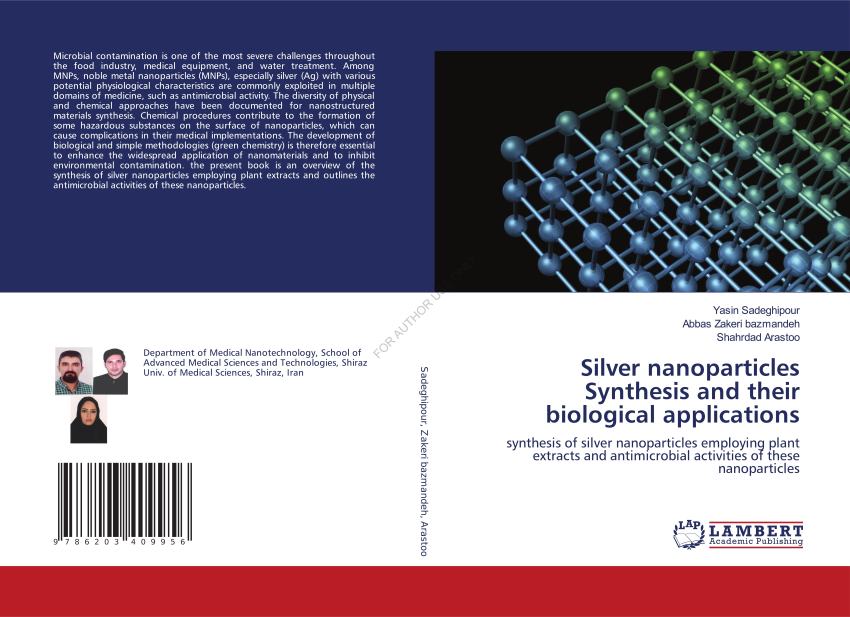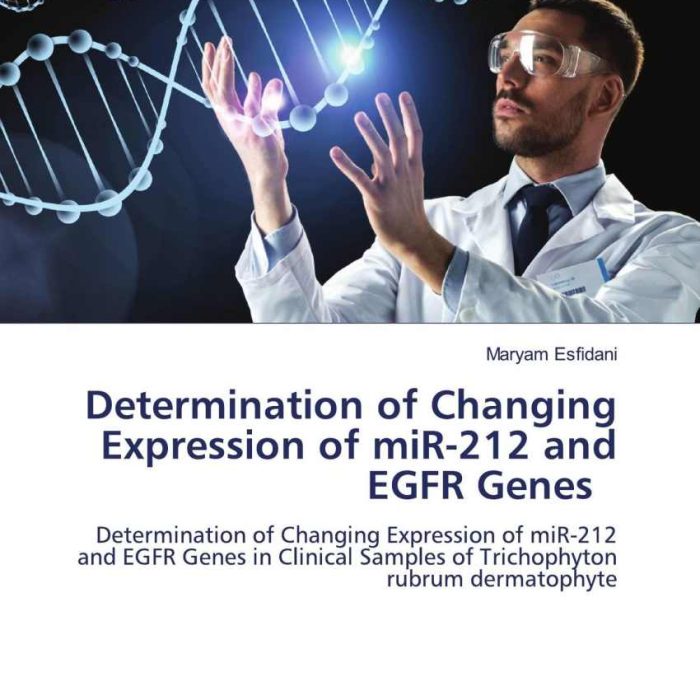کتاب Silver Nanoparticles: Synthesis and Their Biological Applications
۲۱۰,۰۰۰ تومان Original price was: ۲۱۰,۰۰۰ تومان.۱۴۸,۶۸۰ تومانCurrent price is: ۱۴۸,۶۸۰ تومان.
| تعداد صفحات | 113 |
|---|---|
| شابک | 978-620-3-40995-6 |
| انتشارات |



کتاب Silver Nanoparticles: Synthesis and Their Biological Applications – کاوشی در فناوری نانو و کاربردهای زیستی
کتاب Silver Nanoparticles: Synthesis and Their Biological Applications یک مرجع جامع و علمی است که به بررسی روشهای سنتز نانوذرات نقره و نقش آنها در کاربردهای زیستی میپردازد. این اثر با رویکردی میانرشتهای، فناوری نانو را در زمینههایی مانند پزشکی، کشاورزی و زیستفناوری بررسی میکند.
درباره کتاب Silver Nanoparticles: Synthesis and Their Biological Applications
نانوذرات نقره به دلیل ویژگیهای منحصربهفرد خود، از جمله فعالیتهای ضدمیکروبی و قابلیتهای بیولوژیکی پیشرفته، توجه زیادی را در تحقیقات علمی به خود جلب کردهاند. این کتاب با ارائه دیدگاهی جامع از فرآیندهای سنتز، اصلاح سطح، و مکانیسمهای عملکرد نانوذرات نقره، نقش آنها را در بهبود سلامت و زیستفناوری برجسته میکند.
موضوعات کلیدی کتاب
- روشهای سنتز نانوذرات نقره: تحلیل فرآیندهای شیمیایی، فیزیکی و زیستی برای تولید نانوذرات.
- خواص و ویژگیها: بررسی ساختار، اندازه و ویژگیهای منحصربهفرد نانوذرات نقره.
- کاربردهای زیستی: از کاربردهای پزشکی و دارویی تا نقش نانوذرات در صنایع کشاورزی و زیستفناوری.
- چالشها و راهحلها: بررسی مسائل زیستسازگاری و ایمنی استفاده از نانوذرات در محیطهای مختلف.
ویژگیهای برجسته کتاب Silver Nanoparticles
- تحقیقات بهروز: ارائه اطلاعات مبتنی بر جدیدترین مطالعات و دستاوردهای علمی.
- رویکرد میانرشتهای: ترکیب مفاهیم شیمی، زیستشناسی و فناوری نانو برای ارائه دیدگاهی جامع.
- مطالعات موردی: ارائه مثالهای واقعی از کاربردهای نانوذرات نقره در حوزههای زیستی.
- متن علمی و ساده: نوشتهای با ساختار منظم و قابلفهم برای مخاطبان متخصص و غیرمتخصص.
چرا کتاب Silver Nanoparticles را بخوانید؟
این کتاب منبعی ارزشمند برای دانشجویان، محققان و متخصصانی است که به دنبال درک عمیقتر از فناوری نانو و کاربردهای زیستی آن هستند. مطالعه این اثر میتواند شما را با جدیدترین روشها و راهکارها در استفاده از نانوذرات نقره آشنا کرده و افقهای تازهای را در پژوهشهای علمی و صنعتی بگشاید.
مخاطبان کتاب Silver Nanoparticles
- پژوهشگران حوزه فناوری نانو: برای آشنایی با تکنیکهای پیشرفته سنتز و کاربرد نانوذرات.
- دانشجویان علوم زیستی و شیمی: برای درک بهتر مفاهیم پایه و کاربردهای عملی نانوذرات نقره.
- متخصصان پزشکی و داروسازی: برای کشف راهکارهای جدید در توسعه درمانهای مبتنی بر نانو.
- علاقهمندان به علم و فناوریهای نوین: برای آشنایی با کاربردهای پیشرفته فناوری نانو.
سفارش کتاب Silver Nanoparticles: Synthesis and Their Biological Applications
برای خرید این کتاب و بهرهمندی از دانش تخصصی در زمینه سنتز و کاربردهای زیستی نانوذرات نقره، به فروشگاه سایت مراجعه کنید یا با ما تماس بگیرید. این اثر دریچهای به دنیای نوین فناوری نانو و کاربردهای زیستی آن است.
1. کتاب “Silver Nanoparticles: Synthesis and Their Biological Applications” درباره چه موضوعاتی صحبت میکند؟ 📚
پاسخ: این کتاب به معرفی نانوذرات نقره، ویژگیها، خواص و کاربردهای آنها میپردازد. همچنین روشهای سنتز نانوذرات نقره و ویژگیهای بیولوژیکی آنها، به ویژه در کاربردهای پزشکی، آنتیباکتریالی، آنتیویروسی و سایر زمینهها بررسی شده است.
2. چه ویژگیهایی باعث محبوبیت نانوذرات نقره در کاربردهای پزشکی و بیولوژیکی شده است؟ ⚕️
پاسخ: نانوذرات نقره به دلیل ویژگیهایی مانند خاصیت آنتیباکتریالی، آنتیویروسی، و توانایی تسهیل فرآیندهای درمانی، در پزشکی بسیار محبوب هستند. این نانوذرات به درمان بیماریهای مختلف از جمله عفونتهای باکتریایی، ویروسی و قارچی کمک میکنند.
3. در کتاب، چه کاربردهایی برای نانوذرات نقره در پزشکی ذکر شده است؟ 🏥
پاسخ: نانوذرات نقره در درمان عفونتهای میکروبی، تولید تجهیزات پزشکی، ضدعفونیکنندهها، تجهیزات بالینی و حتی در کاربردهای جدید مانند داروهای ضد تومور و تصفیه آب به کار میروند.
4. آیا نانوذرات نقره برای بدن انسان سمی هستند؟ ⚠️
پاسخ: سمی بودن نانوذرات نقره بستگی به ویژگیهای فیزیکوشیمیایی آنها مانند اندازه، شکل، بار سطحی و پایداری دارد. این عوامل میتوانند تاثیرات مختلفی بر سلامت انسان داشته باشند، بنابراین مطالعات دقیقی برای ارزیابی سمی بودن این نانوذرات انجام میشود.
5. چطور میتوان نانوذرات نقره را سنتز کرد؟ 🔬
پاسخ: نانوذرات نقره از طریق روشهای مختلفی مانند روشهای شیمیایی، فیزیکی و سنتز سبز (Green Synthesis) تولید میشوند. روشهای شیمیایی و فیزیکی معمولاً نیاز به استفاده از مواد شیمیایی مختلف دارند، در حالی که سنتز سبز به استفاده از عصارههای گیاهی برای کاهش نقره به نانوذرات اشاره دارد.
6. چه عواملی بر سنتز بیولوژیکی نانوذرات نقره تأثیر میگذارند؟ 🌱
پاسخ: عواملی مانند غلظت یونهای نقره، دما، pH واکنش، زمان واکنش و غلظت پیشسازهای کاهنده بر فرایند سنتز بیولوژیکی نانوذرات نقره تاثیر میگذارند. این عوامل میتوانند اندازه و ویژگیهای نانوذرات نقره تولید شده را تغییر دهند.
7. چگونه نانوذرات نقره خواص ضدباکتریایی خود را نشان میدهند؟ 🦠
پاسخ: نانوذرات نقره به دلیل توانایی تولید گونههای فعال اکسیژن (ROS) که موجب آسیب به ساختارهای سلولی میشوند، خواص ضدباکتریایی دارند. این نانوذرات میتوانند به دیواره سلولی باکتریها آسیب بزنند و آنها را از بین ببرند.
8. نانوذرات نقره چه مزایایی نسبت به آنتیبیوتیکها دارند؟ 💊
پاسخ: نانوذرات نقره به دلیل خاصیت ضدباکتریایی گسترده و توانایی مقاومت در برابر مقاومت آنتیبیوتیکی، نسبت به آنتیبیوتیکها مزایای بسیاری دارند. این نانوذرات همچنین میتوانند به صورت مؤثرتر باکتریها را در سطح سلولی هدف قرار دهند.
9. آیا نانوذرات نقره در تصفیه آب هم کاربرد دارند؟ 💧
پاسخ: بله، نانوذرات نقره به عنوان یک عامل ضدعفونیکننده در فرآیندهای تصفیه آب استفاده میشوند. آنها قادرند به راحتی باکتریها و ویروسها را در آب از بین ببرند و آب را به آب آشامیدنی سالم تبدیل کنند.
10. چه عواملی باعث میشود نانوذرات نقره در اندازههای مختلف خواص متفاوتی داشته باشند؟ 📏
پاسخ: اندازه، شکل، بار سطحی، و پایداری نانوذرات نقره میتوانند تاثیر زیادی بر خواص آنها داشته باشند. به عنوان مثال، نانوذرات با اندازه کوچکتر معمولاً توانایی بیشتری در نفوذ به سلولها دارند و خواص آنتیباکتریایی بهتری را نشان میدهند.
11. چطور نانوذرات نقره میتوانند در بیوسنسورها مورد استفاده قرار گیرند؟ 🧬
پاسخ: نانوذرات نقره به دلیل ویژگیهای خاص خود، مانند سطح فعال و قابلیت جذب بالای مواد، در بیوسنسورها برای تشخیص مولکولهای خاص و بررسی پاسخهای بیولوژیکی استفاده میشوند.
12. چه نوع نانوذرات نقرهای در کتاب بررسی شده است؟ 💎
پاسخ: انواع مختلف نانوذرات نقره مانند نقره نیترات، نقره سولفادیازین، نقره زئولیت و خود نانوذرات نقره در کتاب بررسی شدهاند که هرکدام خواص و کاربردهای خاص خود را دارند.
این پرسشها و پاسخها میتوانند به شما در درک بهتر کتاب و مفاهیم مختلف آن کمک کنند. برای هر سوال، توضیحاتی که به کتاب و محتویات آن مرتبط هستند ارائه شده است.
| تعداد صفحات | 113 |
|---|---|
| شابک | 978-620-3-40995-6 |
| انتشارات |
محصولات مشابه
-
کتاب Determining indicators of the underground economy in Iran
۱۴۰,۰۰۰ تومانOriginal price was: ۱۴۰,۰۰۰ تومان.۱۰۳,۶۰۰ تومانCurrent price is: ۱۰۳,۶۰۰ تومان. -
کتاب The fundamental particle manifest
۱۴۰,۰۰۰ تومانOriginal price was: ۱۴۰,۰۰۰ تومان.۹۹,۱۲۰ تومانCurrent price is: ۹۹,۱۲۰ تومان. -
کتاب Determination of Changing Expression of miR-212 and EGFR Genes
۱۶۸,۰۰۰ تومانOriginal price was: ۱۶۸,۰۰۰ تومان.۱۱۸,۹۴۴ تومانCurrent price is: ۱۱۸,۹۴۴ تومان. -
کتاب The Mystic Ladder
۳۲۸,۰۰۰ تومانOriginal price was: ۳۲۸,۰۰۰ تومان.۲۳۲,۲۲۴ تومانCurrent price is: ۲۳۲,۲۲۴ تومان.






